
The View Toward Logan Pass, Glacier National Park/Rebecca Latson
As mentioned in my previous article, I started writing some (relatively) short photography guides detailing a number of photo ops I captured at various pullouts and designated view areas within the national parks I have visited. This series of guides serves those of us who may not have much time to spend in a national park and/or who may not be able to, or have the desire to, hike long distances within the national park boundaries. It’s for those of us happy to capture incredible images from roadside stops or along short, easy trails.
My first guide deals with Glacier National Park and because there are so many awesome vistas within this park, I’ve had to make a 3-part series of just this location. Part 2 takes the visitor from beyond the Logan Pass Visitor Center east toward Siyeh (Sigh-Yee) Bend and on to the Saint Mary entrance. Bear in mind, I am not including every single stop along Going-To-The-Sun (GTTS) Road. This guide deals only with stops I’ve made and photographs I’ve taken at these stops.
Stop #7: After Logan Pass– Descending immediately from the Logan Pass Visitor Center, the pullouts are few and a little narrow (i.e. large enough for just one vehicle). However, there are one or two stops where the photographer can look back from whence he or she came and capture some amazing images. This particular shot, above, has some meaning for me because it’s a comparison of the digital format I’d now adopted with the film image I’d captured some 13+ years earlier when I made my first solo trip back to this park after an almost 25-year absence.
If the day is sunny, you can use a smaller aperture (f/11 or f/16 – the bigger the number, the smaller the aperture opening) to capture all of the color and contrast of the scene. Use a circular polarizer to make the colors pop.

Siyeh Bend Vista, Glacier National Park/Rebecca Latson

Mountain Clouds and Steamy Road Along Siyeh Bend, Glacier National Park/Rebecca Latson
Stop #8: Siyeh Bend– This hairpin curve has a number of large pullouts because it’s also the entrance for both Piegan Pass and Siyeh Pass trailheads. Don’t just point your camera toward Going-To-The-Sun Mountain and landscapes in that one direction, though; turn around and look back along the road. You might find an interesting photo op, especially if the cloud bank is low and steam is issuing from the road after a quick rain shower on a hot summer’s day. Use your polarizer to bring out the texture in the clouds and steam.
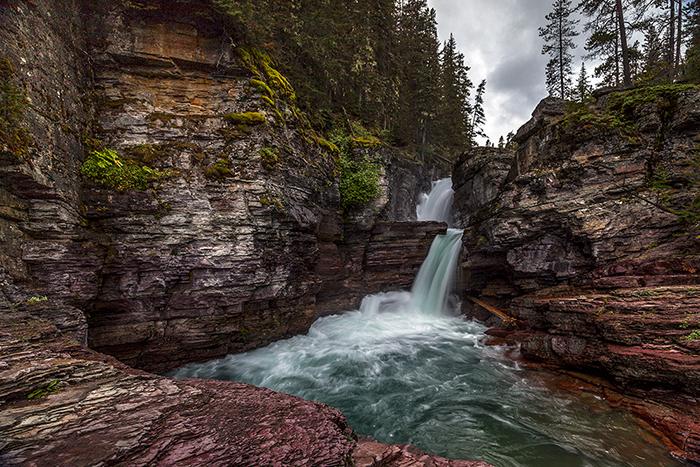
Saint Mary Falls, Glacier National Park/Rebecca Latson

Cool Breezes And Sweet Waters Along The Path To Virginia Falls, Glacier National Park/Rebecca Latson
Stop #9: Saint Mary Falls – Here is another extremely popular trail within the park. It’s short, easy hike and takes the visitor to a gorgeous frothy waterfall with a deep turquoise stripe issuing from, and surrounded by, dark burgundy rock (the Grinnell Formation) and falling into the clear turquoise flow of the Saint Mary River. Cross the bridge and continue onward to some lovely views while hiking toward Virginia Falls, if you are so inclined to lengthen your walk.
Much like the Weeping Wall stop in Part 1 of this guide, the amount of snowmelt and the time of year has much to do with the amount of water at Saint Mary Falls. The photograph of the falls, above, was taken mid-August, on a rainy day, which proves that one shouldn’t let a little precipitation keep one from this trail. Overcast days tend to saturate existing colors and bring out their true hue. Rain clouds also provide an interesting texture and drama to the digital or film canvas. The falls is a fantastic place to affix your ND filter to your lens and play around with slower shutter speeds to achieve silky water shots. You might even also want to affix your polarizer to your ND filter (stacking filters), or consider purchasing a specialized filter that combining the qualities of the ND and polarizing filters. Singh-Ray produces a number of such filters, but they are expensive.

Sunrift Gorge, Glacier National Park/Rebecca Latson

Little Waterfall Near Sunrift Gorge, Glacier National Park/Rebecca Latson
Stop #10: Sunrift Gorge –A very short trail leads the visitor to this small canyon cut into the fractured bedrock by Baring Creek. The gorge itself is a tricky piece of photography because of the sharp contrast between light and dark areas. You’ll either need to take two photos (setting your exposure first for the light areas and then for the dark) and then blend them in your photo editor, or choose an exposure, take the photo, then play around with your highlights and shadows in your photo editor during the post-process stage.
Take the trail away from Sunrift Gorge and you’ll be rewarded with several smaller falls leading you beneath an overpass and on toward Baring Falls. If you choose, you can take a path to Sun Point or instead hike to Saint Mary Falls from this trail. This is another great place to practice getting silky water shots.

Saint Mary Lake Sunrise, Glacier National Park/Rebecca Latson

Evening At Saint Mary Lake, Glacier National Park/Rebecca Latson

Little Cutie, Glacier National Park/Rebecca Latson
Stop #11: Any Pullout Alongside Saint Mary Lake – As GTTS Road descends from Siyeh Bend, you’ll see a number of wider pullouts paralleling Saint Mary Lake. Any stop you make will yield some incredible images. Use your polarizing filter to cut out glare on the deep blue-green water and increase the saturation of that gorgeous color.

Swath Of Sun At Saint Mary Lake, Glacier National Park/Rebecca Latson
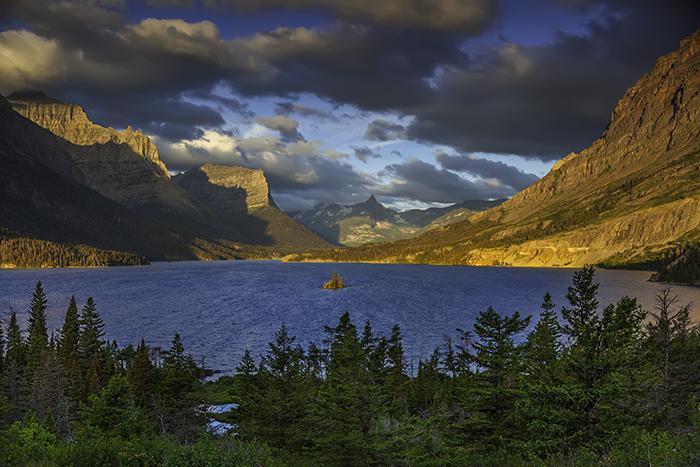
Early Morning At Wild Goose Island View Area, Glacier National Park/Rebecca Latson
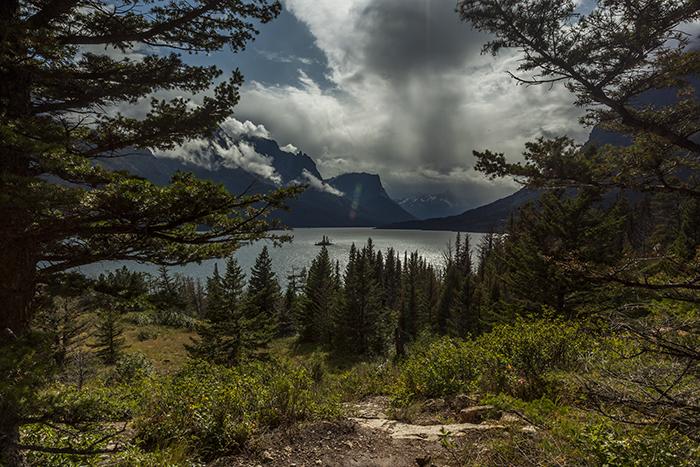
Storm And Sun At Wild Goose Island View Area, Glacier National Park/Rebecca Latson
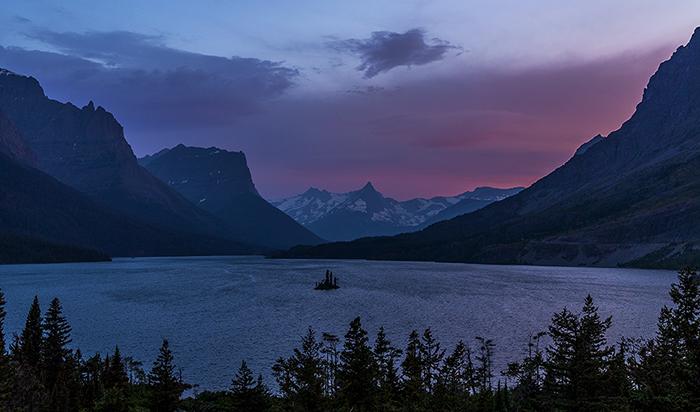
Sunset At Wild Goose Island View Area, Glacier National Park/Rebecca Latson
Stop #12: Wild Goose Island View Area – This stop is definitely one of the most-photographed areas within this portion of the park (maybe even the most-photographed area in the park, period), and with good reason. It’s difficult to get a bad shot, no matter what time of day or season. Weather, sun position, season, wind (or no wind) can make this area look totally different during different times of the same day. You can stand on the nice smooth rock outcroppings or you can take a narrow path down to the water’s edge. Just remember to make lots of noise to warn away any bears roaming the woods.
Sunrise images are incredible at this stop because the sun – on a clear day – will paint a swath across the mountain to the right of your composition. Sunset images may be more subdued, depending upon the quality of the air as well as the type of weather.
No matter what time of day or time of year you visit this photo stop, make sure you have your polarizer and grad ND filters with you because this is the place you will want to use them.
After reading through this Part 2 (and Part 1, as well), you’ll see that I’m a big believer in having a polarizing filter, grad ND filter, and regular ND filter in my photo arsenal. I believe every photographer should carry these three filters in their gear bag.
Regarding lenses, I always take my 16-35mm lens, and my 70-200mm lens. If I have enough room, I’ll bring my 24-70mm and 100-400mm lenses, too. If you are short on packing space, bring just two lenses: a wide-angle lens (anywhere from 11mm to 35mm) and a long (telephoto) lens (anywhere from 200mm to 400mm). Zoom lenses offer plenty of leeway regarding focal lengths, which is why I like them best for travel.
There are other little stops along the way after Wild Goose Island just prior to reaching the Saint Mary Visitor Center. The flat field across the road from the Visitor Center yields a great view of Red Eagle Mountain and oftentimes (especially during the fall), wildlife such as elk and even bears.
Here ends Part 2 of my armchair Glacier National Park photo guide. I’ll continue with Part 3 next month, featuring stops and trails within one of my favorite areas of the park: Many Glacier.
Author's Note: I'd written and scheduled my Glacier National Park guides shortly before the Reynolds Creek fire started in the park. My heart is heavy over the destruction, and I know that some portions of the park may look much different from the images seen here, once the smoke has cleared. There is, however, a certain stark, lonely beauty in a wild land that has been visited by fire. Within these places, life will find a way. The fireweed will show up, with its bright blooms, followed by other plants not too soon thereafter. Smaller animals will start to forage through the new growth. So, don't put your camera away while you mourn the charred landscape. Instead, put that camera's viewfinder to your eye ad look for the opportunity to find beauty amongst the ashes while you look forward to the time when life returns in abundance.
Many thanks to the firefighters and staff who worked diligently to minimize the spread of the fire and keep the park's visitors safe and sound.
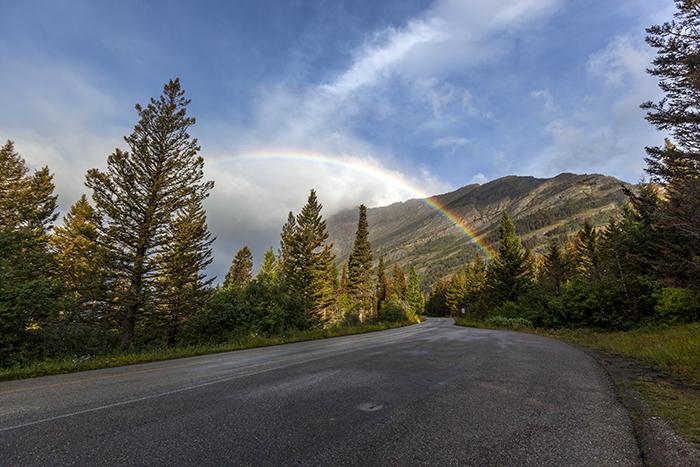
Rainbow Over The Road, Glacier National Park/Rebecca Latson



Comments
Rebecca, these guides are quite timely as we will be making our first trip to Glacier NP next week. I am printing them out and carrying them with me. Since we only have 5 days I want to maximize the photo ops and your guides were just what the doctor ordered. I just wish part 3 was out ;).
Thanks so much.
Thanks for these articles on Glacier NP! I am headed there in about 4 weeks for a photography workshop and appreciate reading your thoughtful tips and advice. Hurry and get part 3 put before I leave!
Just beautiful.